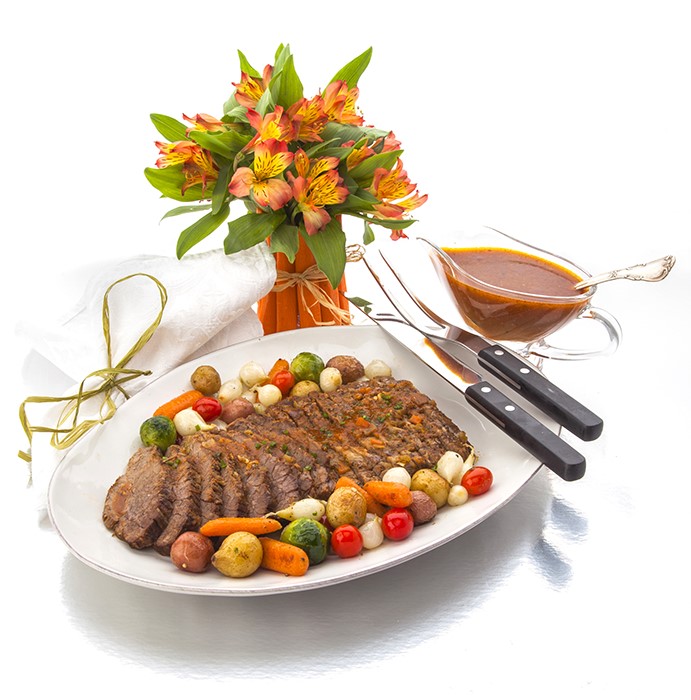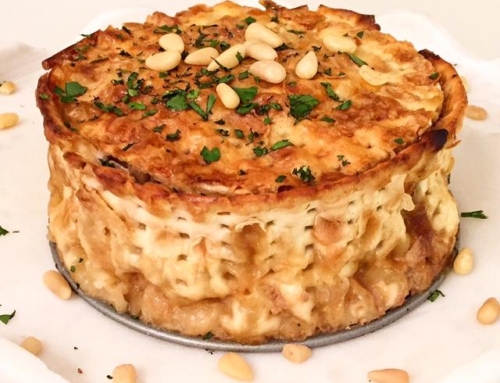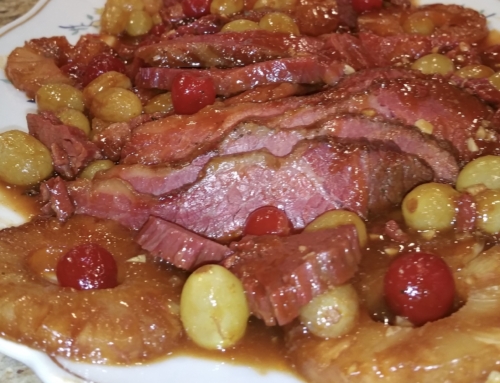A braised brisket of beef is just what the doctor ordered for a cold and dreary late winter’s eve. This recipe demonstrates a braising technique, which yields a toothsome and tender piece of meat that melts in your mouth. A special cut of brisket is first seared and then slow-simmered in a tomato/wine broth seasoned with garlic, basil, thyme, and oregano. I like to serve braised brisket of beef with roasted potatoes or an assortment of colorful roasted vegetables. I also like to add of touch of fun and color to cheer up the winter weary by making a vase out of one of the ingredients used in the recipe.
Ingredients
- 1 to 2 tablespoons canola oil
- 2 ½ to 3 pounds brisket of beef, second cut*
- onion powder
- garlic powder
- salt and freshly ground pepper
- 1 medium onion, chopped
- 2 stalks celery, chopped
- 2 carrots, chopped
- 6 garlic cloves, minced
- ½ teaspoon dried basil
- ½ teaspoon dried oregano
- ¼ teaspoon dried thyme
- 8 ounces tomato sauce
- ½ cup good quality white wine
- 2 cups chicken stock
- 1 bay leaf**
Preheat the oven to 325 degrees.
Heat the oil in a Dutch oven or any heavy, oven safe pot with a tight-fitting lid that is large enough to hold the brisket. Place the brisket on a large cutting board and sprinkle the top and bottom generously with the onion powder, garlic powder, salt and freshly ground pepper.
Place the seasoned brisket into the hot oil and sear on both sides until nicely browned—about 5 minutes per side.
Remove the brisket from the Dutch oven and place the onion, celery, carrots and garlic into the hot oil. Lower the heat and sauté for about 10 minutes until the vegetables are softened and translucent.
Sprinkle the basil, oregano, and thyme on the vegetables and cook for about one minute to release the aromatic flavors.
Pour in the tomato sauce, white wine, and chicken stock. Add the bay leaf and mix well all ingredients.
Replace the seared brisket into the liquid/vegetable mixture and bring to a boil.
Place the brisket into the preheated oven for 2 and ½ hours.
After 2 and ½ hours, the brisket will be fork tender. Allow it to cool a bit, then remove from the Dutch oven.
There will be at least a couple of cups of pan juices infused with wine, tomatoes and garlic. Strain the juices to remove the vegetables. Discard the vegetables and the bay leaf. Make sure to reserve the pan juices, which will serve as a gravy for the meat.
At this point I put the brisket and the pan juices into the refrigerator to cool for at least a few hours or overnight. After a stint in the fridge, the brisket slices easily. The fat in the juices has risen to the top and hardened and removes easily as well.
To serve, pour about ¼ cup of chicken stock (to keep the meat from drying out) over the sliced brisket and place into a preheated 350 oven for 10 minutes. In a small pot, heat up the pan juices/gravy.
Place the heated sliced brisket onto a serving platter and spoon some of the gravy over it.
Place the remainder of the gravy in a sauceboat to pass around.
Serves 4 to 6
March 2015
Notes
*I prefer to use the second cut of brisket for this recipe. It is extremely flavorful and produces a superior pot roast. If you want to double this recipe, you will have to ask for 2 portions of second cut briskets, since the second cut is usually not larger than 2 and ½ to 3 pounds. It is okay to use a first cut of brisket for larger portions that come all in one piece. It is also ok to use any other cuts of meat that do well in a pot roast. A chuck roast would be a good substitution for the brisket in this recipe.
**Make sure to remove the bay leaf from the sauce before serving.







